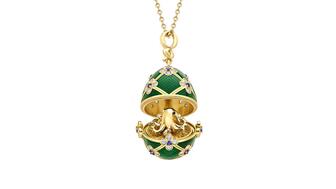Set in a Tiffany & Co. necklace, it sold for $4.2 million, the highest price and price per carat paid for a Paraíba tourmaline at auction.
Squirrel Spotting: Don’t Forget the ‘Sales’ in Salesperson
Peter Smith shares a dozen tips meant for both new and experienced salespeople.

Few people choose sales as a calling, and yet there are more than 8 million people making a living selling in retail, though often the selling part is more implied than realized.
Our industry can be even more challenging because we tend to be forgiving of people who don’t do well with the selling part of the job. If salespeople are honest, pleasant and especially if they are easy to manage … Well, we can always hire a trainer or send them to a conference somewhere.
Just about every book, blog and white paper I’ve read on the topic suggests that about 50 percent of people who make their living in sales should be doing something else for a living. In research for my book, “Hiring Squirrels,” we tested more than 700 salespeople over a five-year period and found that 58 percent of them should not be selling for a living.
Most of those folks were good, honest people who loved working in jewelry stores. They just don’t stress the selling part too much.
In her book “Grit, The Power of Passion and Perseverance,” Angela Duckworth wrote: “I could think of a lot of people who’d racked up decades of experience in their jobs but nevertheless seemed to stagnate at a middling level of competence. I’m sure you can, too. Think about it. Do you know anyone who’s been doing something for a long, long time—maybe their entire professional lives—and yet, the best you can say of their skill is that they’re pretty much OK and not bad enough to fire.”
Whether you fall into the 58 percent who are not wired for sales or the 42 percent who have the appropriate wiring, there are certain tenets that will help you to a better sales person.
Likewise, whether you have 10 or more years of experience, or if you’ve just started in retail sales, there are things that you can do to make a difference.
Jeff Haden, a writer for Inc. and one of the most-read contributors on LinkedIn, said it best in his new book, The Motivation Myth: “We all say we want to achieve things, but we don’t really want to achieve them unless we are willing to take the necessary steps to achieve what we say we want.”
If you would like to be a better salesperson, start by adopting the right mindset
1. Bring Your Best Attitude
The attitude that you bring to work is more important than all the training or experience in the world. If you love what you do, let it show. And one of the best ways to ensure that happens is to avoid negative people as if your life depends on it and be the best you possible. If you’re not happy, don’t bring a bad attitude to work; find another job.
2. Don’t Dwell on Yesterday
Sales is a today game. There are, of course, seeds to be planted and works in progress, but you’ve got to view each day as the first day of the rest of your life. Make it count, and don’t live off yesterday’s accomplishments or allow yesterday’s disappointments to define you. Have an action bias. Do something that will generate sales and accept that everything else is secondary to that goal. Far too many salespeople engage in busy work—easy on the eye and unrelated to making sales, the very lifeblood of every company.
3. Own Your Results
Someone, somewhere has got to have written a book of excuses (I think it would be a fun future column; feel free to send me yours.) Get it, read it and exorcise those demons. Excuse-making is tiresome and accomplishes nothing. No one cares if your manager is useless, or you think someone stole a sale from you. Make things happen and know that no one in the history of mankind has ever accomplished anything worthwhile without encountering some crap along the way. You’re a salesperson. Sell something.
4. Plant Seeds at Every Opportunity
Not every customer is going to buy from you today. We all know that. But give them the opportunity to do so. Believe that they will buy now and behave accordingly. At worst, make sure the experience is engaging enough for the customer that if he/she doesn’t buy today they will want to come back and buy from you in the future. Sales is a math game. The more effort you put into actually selling stuff, the more success you will enjoy.
5. Find Your Favorite Products
Identify your favorite products and take every opportunity to show them. If a customer is picking up a repair, an appraisal or buying something very small, show that customer one of your favorite pieces. Be energetic and be authentic, and that honest enthusiasm will translate to your customers. As expensive as it is to drive customers into your store, it is nothing short of criminal not to use every opportunity to engage customers.
6. Don’t Overwhelm with Options
If you haven’t heard of the paradox of choice, Google it. It means that the more choices you give a customer, the more difficult it is for him or her to make a buying decision. Ask the right open-ended questions. Listen. And then listen some more. Then present three options to the customer so that he or she feels like they have manageable options. If you find yourself showing too many products, you probably didn’t ask the right questions and listen enough.
7. Present Three Price Points
If your customer shared a desired price, let’s say $1,000, present them with three options (remember No. 6) at approximately $1,000, $1,500 and $2,000. This is called the contrast principle or anchoring. By showing the $1,000, you are letting the customer know that you heard when he or she offered that price range. The $2,000 option serves as an anchor. It is occasionally selected but, more often, sets up the middle price ($1,500) as the best, and most-often-picked, option.
8. Quit Linking Value and Price
Weak salespeople often say that a given product or brand is too expensive. What they are really doing is spending from their own pockets and making excuses for the real work that they should be doing—understanding and passionately articulating the value proposition. If you do have the privilege of selling beautiful, well-made products, figure out what the value proposition is and tell that story authentically and unapologetically. If you are selling sub-standard products, you have my condolences. Poor quality is never a good value. Ever.
9. Mind Your Body Language
In a famous study on communication at UCLA, Albert Mehrabian concluded that our words account for 7 percent of what is communicated. Tone of voice is another 38 percent and physiology (body language) is a whopping 55 percent. So put a smile on your face, make sure your body language is open and welcoming, lean in to your customer, and use your hands to gesture and communicate. A study of the most popular TED Talks revealed that speakers who used their hands a lot to communicate rated much higher than those who did not, even when the content was very similar.
10. Ask for the Sale
I am not a fan of capital punishment, but I might be persuaded to make an exception for salespeople who think it is beneath them to ask the customer for the sale. When research participants are asked to list their biggest regrets, they indicate regrets of inaction over action by a more than two-to-one margin. Do you personally have regrets about things you could have bought but didn’t? Yep. Me too. Give the customer permission to buy by asking for the sale.
11. Listen
Ask open-ended questions and listen to what the customer is telling you. Listen to what the customer’s body language is communicating and listen for what he or she is not telling you. Don’t listen to further your agenda; listen to understand what the customer’s real motivation is, even if he or she can’t readily articulate that to you.
12. Study the Craft of Sales
We all agree that product knowledge is essential in our industry. BS’ing your way through your incompetence has a very short shelf life. However, having product knowledge does not make you a great salesperson. It makes you a knowledgeable salesperson. Practice the art of selling on a regular basis. Subscribe to blogs, read books, find relevant YouTube content and watch TED Talks on the art of sales. It is no coincidence that the very best salespeople, those whom one might think need sales training the least, are always looking to polish their technique and learn something new.
This list is not intended to be comprehensive. Sales is ever-evolving and anyone who is serious about being great must also be committed to continually learning and challenging your own long-held perceptions.
I’d love to hear from you if you have something to contribute to this topic.
Peter Smith is president of Vibhor, a public speaker and author of “Sell Something” and “Hiring Squirrels.” He spent 30 years building sales teams in retail and wholesale and he can be contacted at dublinsmith@yahoo.com, peter@vibhorgems.com, or on LinkedIn, Facebook or Twitter.
The Latest

The jeweler’s “Deep Freeze” display showcases its iconic jewelry designs frozen in a vintage icebox.

Take luxury gifting to new heights this holiday season with the jeweler’s showstopping 12-carat sphene ring.

How Jewelers of America’s 20 Under 40 are leading to ensure a brighter future for the jewelry industry.

This year's theme is “Unveiling the Depths of the Ocean.”


In its annual report, Pinterest noted an increase in searches for brooches, heirloom jewelry, and ‘80s luxury.

Starting Jan. 1, customers can request the service for opal, peridot, and demantoid garnet.

Roseco’s 704-page catalog showcases new lab-grown diamonds, findings, tools & more—available in print or interactive digital editions.

The new catalog features its most popular chains as well as new styles.

The filmmaker’s personal F.P. Journe “FFC” prototype was the star of Phillips’ recent record-setting watch auction in New York.

The new location in the Design District pays homage to Miami’s Art Deco heritage and its connection to the ocean.

Inflations, tariffs, and politics—including the government shutdown—were among consumers’ top concerns last month.

“Longtime favorite” presenters, as well as first-time speakers, will lead talks and workshops at the annual event in Tucson next year.

Silas Smith of Meridian Metalworks won the challenge with his pendant that blends Australian and American landscapes.

The sale of the 31.68-carat, sunset-hued stone was part of Sotheby’s first series of events and auctions in Abu Dhabi.

Most customers who walk into your store this month have made up their minds. Your job is to validate their choice, Emmanuel Raheb writes.

The collection features characters and motifs from Ukrainian folklore, including an enchanted mirror and a magic egg.

MatrixGold 3.11, the newest version of the jewelry design program, offers more flexibility, precision, and creative control.

The pavilion will be part of the 2026 JA New York Spring show, scheduled for March 15 to 17.

Kadet, a 1994 National Jeweler Retailer Hall of Fame inductee, helped grow the family-owned retailer in the Chicago area and beyond.

Billed as the world’s smallest wearable, Lumia Health’s new smart earrings have a health tracker subtly embedded in the back.

Don’t let those with December birthdays feel blue. Help them celebrate their month with blue zircon, turquoise, and tanzanite.

The new pink sapphire version of the piece dances with its wearer in the brand’s “Icons After Dark” holiday campaign.

A choice that’s generated a lot of commentary, Pantone says “Cloud Dancer” marks a fresh start and encourages relaxation and creativity.

The manufacturer’s holiday campaign features a gift guide filled with trending designs and jewelry that can be personalized.

The man was charged with theft, accused of ingesting the necklace while in a jewelry store in Auckland, New Zealand.

Sponsored by De Beers Group



























